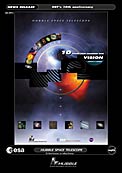heic9913 — Science Release
HST's 10th anniversary: ESA and Hubble - changing our vision
17 April 2000
To mark the Hubble Space Telescope's tenth anniversary, ESA is hosting a press conference at the Space Telescope-European Coordinating Facility (ST-ECF) in Munich on Thursday 27 April .With the astronauts who took part in the most recent Servicing Mission (SM3A) in attendance, ESA is taking the opportunity to give a - first - complete overview of Europe's major contribution to the HST mission. It will also review the first ten years of operations and the outstanding results that have 'changed our vision' of the cosmos. A new fully European outreach initiative - the 'Hubble European Space Agency Information Centre' - will be presented and officially launched it has been set up by ESA to provide information on Hubble from a European perspective.The new Hubble ESA Information Centre web pages go online here on 27 April.
Not only has Hubble produced a rich harvest of scientific results, it has impressed the man in the street with its beautiful images of the sky. Thousands of headlines all over the world have given direct proof of the public's great interest in the mission - 'The deepest images ever', 'The sharpest view of the Universe', 'Measurements of the earliest galaxies' and many others, all reflecting Hubble's performance as a top-class observatory.
The Servicing Missions that keep the observatory and its instruments in prime condition are one of the innovative ideas behind Hubble. Astronauts have serviced Hubble three times, and ESA astronauts have taken part in two of these missions. Claude Nicollier (CH) worked with American colleagues on the First Servicing Mission, when Hubble's initial optical problems were repaired. On the latest, Servicing Mission 3A, both Claude Nicollier and Jean-Frangois Clervoy (F) were members of the crew.
Over the next 10 years European scientists still plan to use Hubble as one of their prime research tools, but they also expect to benefit from synergy between Hubble and the ground-based 8-metre class telescopes that are becoming available to scientists in Europe.
Press event programme
10:30 Catherine Cesarsky, ESO Director General: 'Welcome address: The Synergy between Ground and Space-based astronomy'
10:40 Roger M. Bonnet, ESA Director of Science: 'ESA and Hubble: Changing our Vision'
10:50 Piero Benvenuti, ESA HST Project Scientist: 'Hubble's Impact on Science'
11:00 tbd
11:10 Servicing Mission Astronauts: 'Working with Hubble in Space'
11:15 Hugo Marie, ESA Science Programme Communication Service: 'The ESA Hubble Information Centre and Its Services'
11:30 Q&A;
12:30 Cocktails & lunch - informal Q&A;, interview opportunities
Public Conference Thursday 27 April at 15:00h
Location Hvrsaal MW 2001 (Rudolf-Diesel-Hvrsaal) Technische Universitdt, Fakultdt fur Maschinenwesen Bolzmannstr. 15, Forschungsgeldnde D-85748 Garching bei Munchen Germany
Everyone interested is welcome.
Programme 15:00 Roger Bonnet, ESA Director of Science: 'Welcome and introduction'
15:15 Piero Benvenuti, ESA HST Project Scientist: '10 years of Hubble Science'
15:30 Servicing Mission Astronauts: 'Working with Hubble in Space'
16:30 Q&A;
Notes
The Hubble Space Telescope is an international cooperation project between the National Aeronautics and Space Administration (NASA) and the European Space Agency (ESA).
The partnership agreement between ESA and NASA was signed on 7 October 1977. ESA has provided, among other items, two pairs of solar panels and one of Hubble's scientific instruments (the Faint Object Camera). 15 European scientists are contributing to the science operation of the Hubble Observatory and are currently working at the Space Telescope Science Institute in Baltimore (STScI). In return for this contribution, European astronomers have guaranteed access to 15% of Hubble's observing time.
Scientific operation of the Hubble Observatory is the responsibility of the Space Telescope Science Institute, which is run for NASA by the Association of Universities for Research in Astronomy (AURA).
The Space Telescope European Coordinating Facility (ST-ECF), hosted by the European Southern Observatory (ESO) in Garching near Munich, Germany, provides support to European Hubble users. ESA and ESO jointly operate ST-ECF.
From 27 April 2000 the 'European Space Agency Hubble Information Centre' will be available with its services on the World Wide Web at
http://hubble.esa.int
as part of the recently upgraded ESA Science website http://sci.esa.int
Links
Contacts
ESA - Communication Department Media Relations Office Tel: +33(0)1.53.69.7155 Fax: +33(0)1.53.69.7690
Press conference Thursday 27 April at 10:30h
Location
Space Telescope-European Coordinating Facility (ST-ECF) (c/o European Southern Observatory (ESO), K. Schwarzschild-Str. 2, Garching bei Munchen, Germany), Auditorium.
About the Release
| Release No.: | heic9913 |


